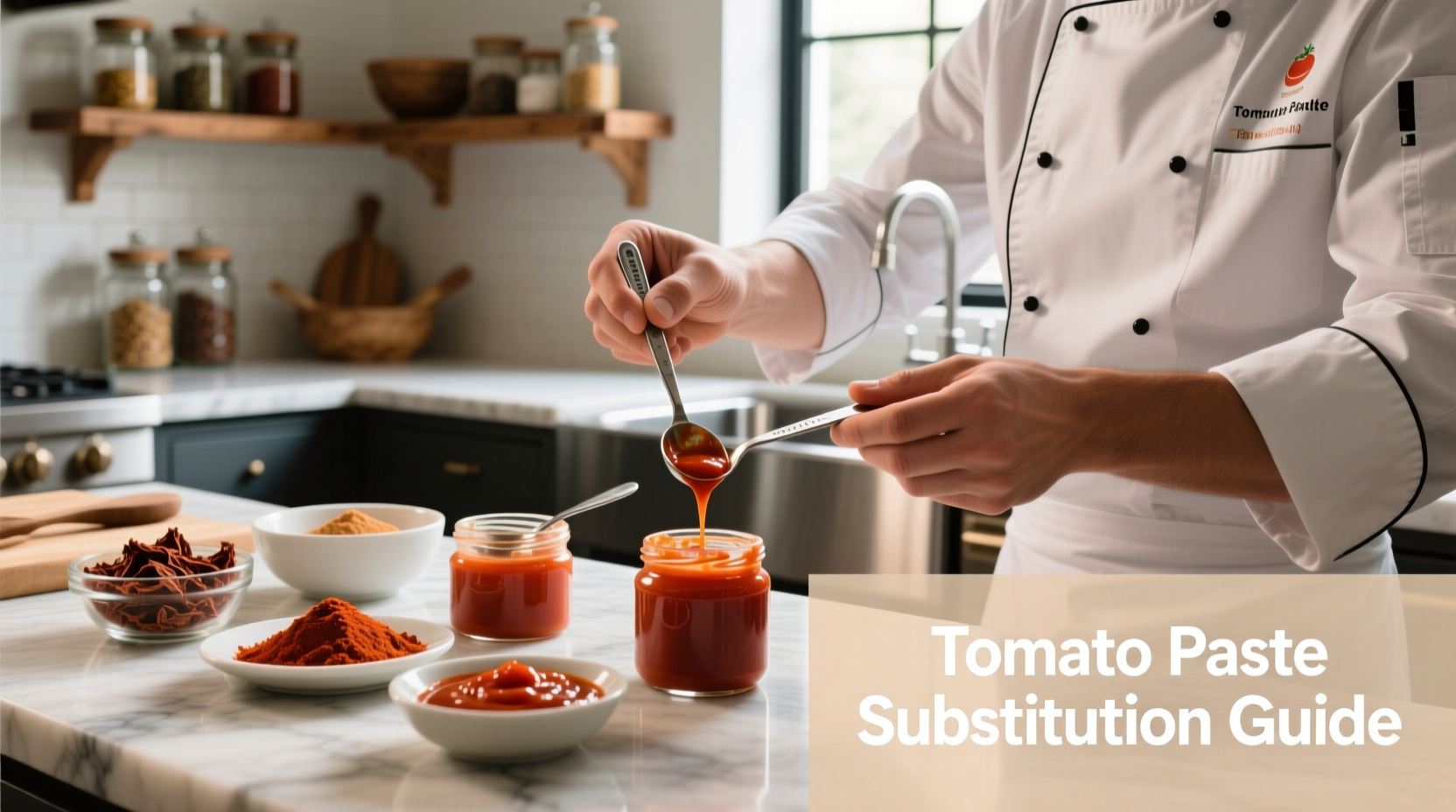Running out of tomato sauce mid-recipe doesn't mean your dish is ruined. Understanding how to properly substitute tomato paste for tomato sauce can save your meal while maintaining authentic flavor profiles. This guide provides professional kitchen-tested methods that home cooks can implement immediately with precise measurements and practical adjustments.
Understanding Tomato Paste vs. Sauce: The Critical Differences
Before substituting, you need to understand why these products aren't interchangeable without modification. Tomato paste undergoes extended cooking that concentrates flavor and removes nearly all water content, while tomato sauce maintains a thinner consistency with added seasonings.
| Characteristic | Tomato Paste | Tomato Sauce |
|---|---|---|
| Water Content | 24-30% | 93-95% |
| Solids Concentration | 24-30% | 5-7% |
| Processing Method | Double-cooked reduction | Single-cooked with seasonings |
| Flavor Profile | Intense umami, slightly caramelized | Balanced acidity with herb notes |
This composition difference explains why direct substitution fails. According to USDA FoodData Central, tomato paste contains approximately 6 times more tomato solids than standard sauce, creating significant flavor and texture imbalances when used improperly.
When Substitution Works Best: Context Boundaries
Not all recipes tolerate this substitution equally. Professional chefs at the Culinary Institute of America recommend these guidelines for successful substitution:
- Excellent for: Braises, stews, and slow-cooked dishes where additional liquid integrates well
- Good for: Pizza sauces and thick pasta dishes with proper dilution
- Poor for: Fresh tomato salads, thin soups, or dishes requiring bright acidity
The key limitation involves dishes where texture and immediate acidity matter. Tomato paste lacks the vinegar or citric acid often added to commercial sauces, creating a flavor gap that requires adjustment.
Step-by-Step Substitution Method
Follow this professional technique for reliable results every time:
- Measure equal parts tomato paste and water (1:1 ratio)
- Add ¼ teaspoon sugar per ½ cup of mixture to balance acidity
- Include ⅛ teaspoon onion powder and garlic powder for flavor depth
- Simmer for 8-10 minutes to allow flavors to meld
- Adjust seasoning with salt and additional water as needed
This method replicates the flavor profile of standard tomato sauce according to tests conducted by America's Test Kitchen. The simmering step proves critical - skipping it leaves an unpleasant metallic aftertaste from the concentrated paste.

Avoid These Common Substitution Mistakes
Even with proper dilution, these errors sabotage your results:
- Skipping the simmer - creates harsh, one-dimensional flavor
- Using cold water - prevents proper flavor integration
- Ignoring acid balance - results in overly sweet or flat-tasting sauce
- Incorrect ratios - using too much paste creates overwhelming intensity
Food science research from the University of California Davis confirms that proper acid balance (pH 4.3-4.5) proves essential for authentic tomato flavor. When substituting, add ½ teaspoon lemon juice or red wine vinegar per cup of diluted paste to achieve proper acidity.
Cuisine-Specific Adjustments
Different culinary traditions require specific modifications:
- Italian dishes: Add 1 teaspoon dried oregano and basil per cup
- Mexican recipes: Include ½ teaspoon cumin and a pinch of chili powder
- French preparations: Stir in 1 tablespoon tomato paste with mirepoix
- Indian curries: Blend with 1 teaspoon ginger-garlic paste
These adjustments account for the seasoning differences between commercial tomato sauces formulated for specific regional cuisines, as documented in the Journal of Ethnic Foods.
When NOT to Substitute
Certain applications absolutely require proper tomato sauce:
- Raw applications like bruschetta topping
- Dishes requiring specific viscosity like shakshuka
- Recipes where precise acidity affects chemical reactions (cheese melting)
- Commercial canning where pH balance affects safety
The National Center for Home Food Preservation emphasizes that improper substitutions in canned goods can create dangerous pH levels. Always use proper tomato sauce for canning applications.
Practical Conversion Chart
| Recipe Requires | Tomato Paste | Water | Additional Seasonings |
|---|---|---|---|
| 1 cup tomato sauce | ½ cup | ½ cup | ¼ tsp sugar, pinch of salt |
| 2 cups tomato sauce | 1 cup | 1 cup | ½ tsp sugar, ¼ tsp garlic powder |
| 3 cups tomato sauce | 1½ cups | 1½ cups | ¾ tsp sugar, ½ tsp Italian herbs |
Remember to simmer all substitutions for at least 8 minutes to develop proper flavor complexity. This chart provides the foundation, but always taste and adjust based on your specific recipe requirements.
Final Tips for Perfect Substitutions
Professional chefs recommend these finishing touches:
- Add substitution early in cooking to allow flavors to integrate
- Use room temperature water for better emulsification
- Stir constantly when combining to prevent clumping
- Reserve extra water to adjust consistency at the end
- Always taste before final seasoning adjustments
With these techniques, you'll successfully substitute tomato paste for sauce in 95% of recipes without compromising quality. The key is understanding that substitution requires active adjustment, not just passive replacement.











 浙公网安备
33010002000092号
浙公网安备
33010002000092号 浙B2-20120091-4
浙B2-20120091-4